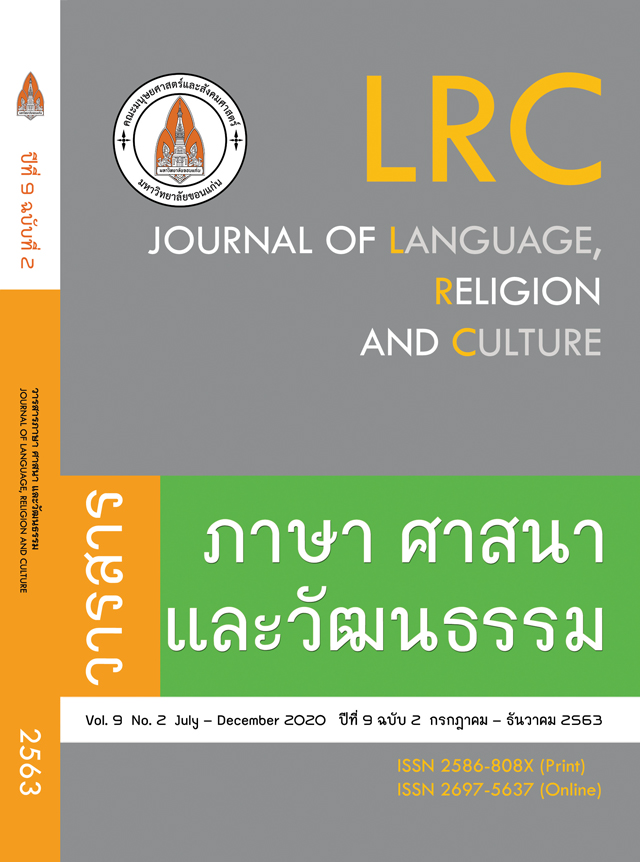การวิเคราะห์องค์ประกอบทางความหมายของคำกริยาที่ใช้มือกระทำในภาษาจีน
A Componential Analysis of Hand-Related Verbs in Chinese
คำสำคัญ:
คำกริยาที่ใช้มือกระทำ, ภาษาจีน, การวิเคราะห์องค์ประกอบทางความหมาย, อรรถเขตบทคัดย่อ
งานวิจัยนี้มีวัตถุประสงค์เพื่อหามิติแห่งความต่างของคำกริยาที่ใช้มือกระทำในภาษาจีนและเพื่อกำหนดอรรถลักษณ์ของคำกริยาที่ใช้มือกระทำในภาษาจีน คำกริยาคัดเลือกจาก 新汉语水平考试 (HSK) 词汇 (2012年修订版) (คำศัพท์การสอบวัดระดับความรู้ภาษาจีนระบบใหม่ ฉบับปรับปรุง ปี ค.ศ. 2012) และ 汉语动词用法词典 (พจนานุกรมวิธีใช้คำกริยาภาษาจีน) จากนั้นใช้การวิเคราะห์องค์ประกอบเพื่อหาอรรถลักษณ์ที่มีร่วมกันและแตกต่างกันของ 1) คำกริยาที่ใช้มือทำให้วัตถุเคลื่อนที่ 2) คำกริยาที่ใช้มือทำให้วัตถุมีการเปลี่ยนแปลง ผลการศึกษาพบว่า มิติแห่งความต่างที่สามารถนำมาใช้พิจารณาความแตกต่างของคำกริยาที่ใช้มือทำให้วัตถุเคลื่อนที่ในทุกอรรถเขต มีมิติทิศทาง มิติอุปกรณ์ มิติการออกแรง มิติปลายทางของวัตถุ มิติจำนวนมือ และด้านวัตถุปรากฏร่วม มีมิติขนาด มิติน้ำหนัก มิติมีชีวิต คำกริยาที่ใช้มือทำให้วัตถุมีการเปลี่ยนแปลง มีมิติทิศทาง มิติอุปกรณ์ มิติการออกแรง มิติจำนวนมือ และด้านวัตถุปรากฏร่วม มีมิติลักษณะของวัตถุ มิติลักษณะของวัตถุหลังถูกกระทำ นอกจากนี้ยังพบมิติแห่งความต่างในบางอรรถเขตที่ช่วยทำให้เห็นความแตกต่างระหว่างคำกริยาในอรรถเขตเดียวกันได้ชัดเจนขึ้น
เอกสารอ้างอิง
กิตติศักดิ์ ใจอารี. (2543). การวิเคราะห์อรรถลักษณ์ของคำกริยาบอกอาการเคลื่อนที่ของวัตถุในภาษาไทย (วิทยานิพนธ์ปริญญามหาบัณฑิต). มหาวิทยาลัยมหิดลม, กรุงเทพฯ.
ชลธิชา สุดมุข. (2537). การศึกษาคำกริยาแสดงอาการโดยไม่กระทบกระเทือนผู้อื่นหรือสิ่งอื่นในภาษาไทยโดยการจัดกลุ่มทางความหมาย (วิทยานิพนธ์ปริญญามหาบัณฑิต). มหาวิทยาลัยธรรมศาสตร์, กร
ชัชวดี ศรลัมพ์. (2559). ระบบความหมาย. ใน ดียู ศรีนราวัฒน์ (บรรณาธิการ). ภาษาและภาษาศาสตร์ (พิมพ์ครั้งที่ 2). กรุงเทพฯ: มหาวิทยาลัยธรรมศาสตร์.
พรรณวดี รัตนศักดิ์, & สุทธา รัตนศักดิ์. (2559). คำกริยาที่แสดงการใช้มือกระทำในภาษาถิ่นเชียงราย. วารสารไทยศึกษา. 12 (2), 65-94.
ราชบัณฑิตยสถาน. (2556). พจนานุกรมฉบับราชบัณฑิตยสถาน พ.ศ. 2554 (พิมพ์ครั้งที่ 1). กรุงเทพฯ: ราชบัณฑิตยสถาน.
สุวิไล เปรมศรีรัตน์. (2526). เรื่องคำ “ตัด” ในภาษาไทย. วารสารภาษาและวัฒนธรรม. 3 (1), 17-29.
เพียรศิริ วงศ์วิภานนท์. (2525). เอกสารการสอนชุดวิชาภาษาไทย 3 หน่วยที่ 13. สาขาวิชาศึกษาศาสตร์ มหาวิทยาลัยสุโขทัยธรรมาธิราช.
Chinese Testing International汉语考试服务网. (2020, August 28). Xin hanyu shuiping kaoshi (HSK) cihui (2012 nian xiudingban) [The New Chinese Proficiency Test Word (2012 revision)]. Retrieved from http://www.chinesetest.cn/godownload.do.
Li, Y. (2017). Xiandai hanyu danyinjie zhifanglei shoubu dongci yanjiu [The Study of Monosyllabic zhifang (置放) Verbs in Modern Chinese] (master’s thesis). Nanjing Normal University, Jiangsu China.
Meng C, Zheng H.D, Meng Q.H, Cai W.L. (1999). Hanyu dongci yongfa cidian [Dictionary of Chinese verbs usage]. Beijing: Shangwu yinshuguan.
Wang, T. (2011). Xiandai hanyu chijulei shoubu dongci de jufa yuyi yanjiu [The Study of the Holding-tool hand Monosyllabic Verbs in Modern Chinese] (master’s thesis). Nanjing Normal University, Jiangsu China.
Zeng, X.B. (2013). Xiandai hanyu danyinjie huoqulei shoubu dongci yanjiu [The Study of the Hand-getting Monosyllabic Verbs in Modern Chinese] (master’s thesis). Nanjing Forestry University, Jiangsu China.
Zhongguo shehui kexue yuyan yanjiusuo cidian bianjishe. (2016). Xiandai hanyu cidian (di 7 ban) [Modern Chinese Dictionary (7th Edition)]. Beijing: Shangwu yinshuguan.







